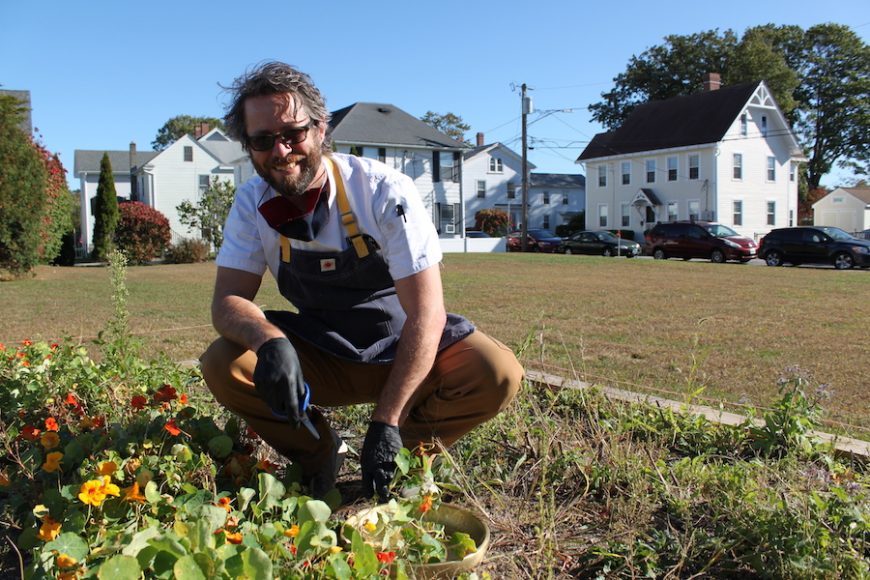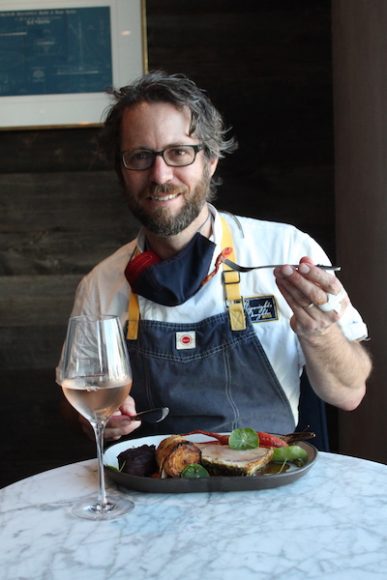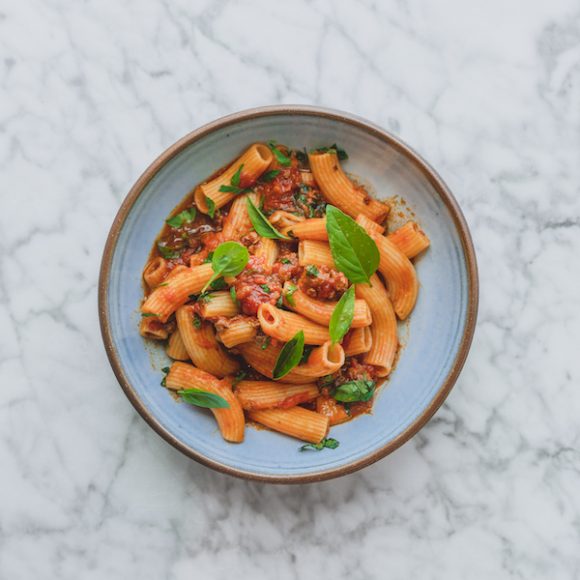When David Standridge received an invitation to become the executive chef of The Shipwright’s Daughter, a fine new restaurant located in the historic Whaler’s Inn in downtown Mystic, it seemed that he was in the right place at the right time.
“I worked in New York City for about 15 years at many restaurants,” recalls Standridge, who earned two Michelin stars working with the French culinary icon Joel Robuchon. “I always described New York City as kind of a treadmill – and I felt like, all of a sudden, that the treadmill was getting ahead of me. So, it was time to look elsewhere.”
Standridge was familiar with the Connecticut resort town from childhood sailing voyages on the Long Island Sound and, in the summer of 2019, he found himself in Mystic with his wife at a birthday party. A connection made at the party brought Standridge to the attention of the Whaler’s Inn management and, within a few weeks, he was tapped to helm this new endeavor.
“It just was a perfect fit for us,” he adds. “And we’re just so happy to be away from the city.”
Standridge’s arrival in Mystic was a new peak in a career that had its beginnings in a considerably less sophisticated environment.
“My initial culinary experience was at a place called Action Park in New Jersey, where I grew up,” he says. “It’s the world’s most dangerous waterpark — there’s a documentary out about it — and I worked in a terrible cafeteria kitchen when I was a teenager. And the food was bad. But the fun was in the camaraderie of the kitchen pace, and it was interesting for me.”
Standridge’s original focus in the hospitality trade was in bartending — he happily recalls a gig in Manhattan’s West Village “making cocktails for Lou Reed every night” — but he eventually realized his future was in the kitchen rather than behind the bar.
“I had that epiphany and I moved to Texas, of all places and went to a very small French culinary school, Culinary Institute Lenotre, where it was basically three students and the chef,” he continues. “From there, I was a cook of the Four Seasons in Houston, and then I moved back to New York — as I have always done in the past every time I’ve tried to leave. Joel Robuchon was opening his first restaurant in the U.S. at that time, and it was just a once in a lifetime opportunity to work for the master, so I took it.”
After working with Robuchon, Standridge took the helm at the popular farm-to-table restaurant Market Table in the West Village, and he later created the health-focused menu concept at Café Clover, Clover Grocer and The Maidstone hotel in East Hampton.
The Shipwright’s Daughter was being readied for a spring 2020 opening when the coronavirus disrupted the world, forcing Standridge to improvise a different debut.
“We didn’t want to open a fine dining restaurant in a parking lot, so we opened an upscale lobster shack instead,” he says.
Today, Connecticut’s restaurants can pursue indoor dining (albeit with reduced seating capacity), and Standridge reports The Shipwright’s Daughter has been “super lucky” in attracting diners since its June opening. A key strategy to building a loyal following, according to Standridge, is “trying to have enough on our menu that is very diverse, where people can have a lot of different dining experiences.” The chef is focused on seasonal ingredients, with an emphasis on locally sourced items from regional farms and off the New England coast.
“In New York, farm-to-table is really a 200-mile radius of New York,” he says. “With farm-to-table in Mystic, the fish is coming right from the docks and the farms are just miles from the restaurant. We try to focus on taking the best of what all of our local producers have and fleshing it out on the menu.”
Standridge also emphasizes sustainability in his ingredients, especially in the seafood. He laments that many chefs only use a relatively small portion of the fish and discard sections that could easily be incorporated into a meal. As an example, he cites one of his creations, bigeye tuna blood sausage.
“When we get a whole tuna or loin of tuna, there’s always this big blood line on it,” he says. “That’s dark meat that’s very full of tuna blood, and no one really eats it in this country. But in Japan, they might braise it or confit it and put it into ramen noodle dish. I ground it up and made a sausage out of it that’s heavily flavored with chili paste, fennel seed and coriander. And then I take it back and we make a traditional Bolognese sauce for pasta. And it’s really delicious.”
Looking ahead to the year-end holidays, Standridge is planning a new spin on the Feast of the Seven Fishes, a traditional Italian-American celebration for Christmas Eve.
“I don’t know if I have them all ready to go yet, but we’re definitely going do a New England-style,” he says. “We’ll do a really great chowder and bring in some squid. But we really won’t know until November what people are catching, so it’s kind of a little experimental.”
Standridge acknowledges there are still challenges for The Shipwright’s Daughter to overcome — most notably, luring many people back into restaurants while Covid-19 persists. Nonetheless, he is appreciative for the opportunity to bring his skills to Connecticut’s dining scene.
“I’m grateful to have a place to go, where I can work and do the thing that I love to do the most,” he says, “and just try to make special food and give people good experiences.”
And there is still one challenge that he still working on — making a fan of his son, who is just shy of 2 years old.
“My son doesn’t like my cooking,” he says with a laugh. “It’s very humbling when you put like a nice plate of food in front of him and he just looks at it, picks up the plate and dumps it on the floor.”
The Shipwright’s Daughter is 20 E. Main St. For more, call 860-536-7605 or visit shipwrightsdaughter.com.
Swordfish Holiday Roast Style With Roasted Kyoto Carrots and Root Vegetable Pinwheels
By Chef David Standridge
Equipment list
• Shallow roasting pan large enough to hold swordfish and vegetables
• Food processo
• Vegetable sheeter or sheeter attachment for KitchenAid mixer (optional)
Ingredients
For the swordfish
• 2-pound piece of swordfish loin on the bone (extra credit with fin attached)
• 2 cups kosher salt
• 1 cup brown sugar
• 1 pound butter, unsalted
• 3 bunches parsley, picked
• 4 cloves garlic
• 1 cup plain bread crumbs
• 2 teaspoons kosher salt
For the sauce
• ½ cup canola oil
• 1 pound swordfish bones, chopped in small pieces
• 4 tablespoons butter
• 5 sprigs thyme
• 1 head garlic
• 2 to 3 cups soy sauce
• 2 to 3 cups red wine vinegar
• ½ cup heavy cream
For the root vegetables
• 16 baby Kyoto carrots (organic preferred)
• 4 medium beets
• 4 small heads celery root
• 3 large sweet potatoes
• 4 medium kohlrabi
• 3 tablespoons butter unsalted
• 1 bunch rosemary
• 1 bunch thyme
• 1 head garlic
• 4 tablespoons canola oil
• Salt and pepper
This is a fun holiday treatment for swordfish. Local swordfish is in season in the fall and available at a high quality. If you are lucky, you can get your hands on a “pumpkin” sword, which is orange in color from eating a diet high in red shrimp. Ask for rod- and reel-caught swordfish as opposed to long-line caught.
A couple of notes on the recipe: If you don’t want to get a vegetable sheeter, just peel the roots and cut into large rounds.
The sauce is an extra step and a really fun technique to learn, but this roast is delicious with or without.
Method
Place swordfish in on a non reactive dish (glass, ceramic, stainless steel). Combine 2 cups salt and 1 cup brown sugar and cover swordfish with the mixture in a thick layer. Allow to cure for 30 minutes.
Rinse swordfish under cold water and pat dry. Reserve in fridge.
In a food processor, combine softened butter, parsley, garlic, breadcrumbs and 2 teaspoons kosher salt. Roll the mixture between two pieces of parchment paper with a rolling pin until about 1/8-inch thick. Refrigerate until cold.
Cut the cold herb crust into the size of the swordfish and peel off the top layer of parchment. Press the crust onto the swordfish and remove the parchment. Reserve in fridge.
In a hot heavy-bottomed skillet, add enough canola oil to cover the bottom of the skillet and sear the swordfish bones until golden brown on all sides.
Add butter, thyme and garlic and continue to brown until butter is golden brown.
Drain the fat and add equal amounts soy sauce and red wine vinegar. Simmer for 1 hour.
Strain out the liquid and reduce until only ¼ of the liquid is still left. Add cream and simmer until sauce consistency.
Preheat oven to 500 degrees F.
Following instructions on sheeter, sheet out the beets, celery root, sweet potato, and kohlrabi, then roll the sheet into tight rolls and tie with butcher’s twine. Season the rolls liberally with salt and pepper.
In a hot pan, sear the rolls until golden brown on both sides. Add butter, herbs and garlic and baste until butter is brown. Remove and reserve.
Toss the carrots in canola oil, salt and pepper.
Place the swordfish in a shallow roasting pan and arrange the vegetable spirals and the carrots around the fish. Roast at 500 degrees F for 10 minutes, then lower the oven to 325 and roast until internal temperature is 120 degrees F (about 40 minutes, depending on oven and size of swordfish).
Allow to rest 10 minutes, then slice and serve. (Serves 4 to 6)
Tuna Bolognese
Ingredients
• 1 pound dry Rigatoni (or 2 pounds fresh)
For the tuna blood sausage
• 1 pound tuna bloodline and scraps (Your fishmonger will have this but be surprised you are asking for it.)
• 1 teaspoon fennel seed, ground
• ½ cup chili paste (1 part each ancho, passilla and chipotle), or 3 tablespoons chili powder
• 1 teaspoon finely chopped ginger
• 1 teaspoon finely chopped garlic
For the sauce
• 2 28-ounce cans whole peeled imported
Italian tomatoes
• 1 small can tomato paste
• 1 medium yellow onion, finely diced
• 2 cloves garlic, finely chopped
• ¼ cup grapeseed oil
• ¼ cup extra virgin olive oil
• ¼ cup basil, chopped
• ¼ cup parsley, chopped
Directions
Grind the tuna bloodline and scraps in a meat grinder. Mix in all the spices and refrigerate overnight.
Heat a large sauce pot (something with a heavy bottom, about 9-inches diameter) until very hot.
Add the grapeseed oil and wait until just starting to smoke.
Sear the ground tuna all at once and stir/scrape the bottom of the pan until it is all seared (about 3 minutes).
Remove tuna and refrigerate.
Add olive oil to pan and sauté onions and garlic until translucent.
Add tomato paste and stir until oil is absorbed and then released back.
Add canned tomatoes, then fill each can with water and add to pot. (The water allows the tomatoes to cook for a longer time, which helps the tomatoes break down.)
Simmer, stirring every 15 minutes, until reduced by 1/3 (about 40 minutes to 1 hour)
Add the tuna back to the sauce and bring to a boil.
Turn off heat, add salt and pepper to taste. Stir in chopped basil and parsley.
Boil some water in a large pot, season generously with kosher salt (until it tastes like the ocean).
Add rigatoni and cook to al dente. Strain and top/toss with tuna Bolognese. Top with more fresh herbs. Serves 4.





